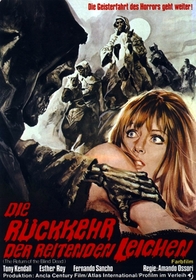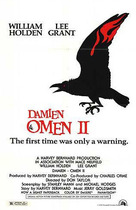Our editor-in-chief Nate Yapp is proud to have contributed to the new book Hidden Horror: A Celebration of 101 Underrated and Overlooked Fright Flicks, edited by Aaron Christensen. Another contributors include Anthony Timpone, B.J. Colangelo, Dave Alexander, Classic-Horror.com's own Robert C. Ring and John W. Bowen. Pick up a copy today from Amazon.com!
Return of the Evil Dead (1973)
Amando de Ossorio's Return of the Evil Dead (aka El ataque de los muertos sin ojos), the sequel to the writer-director's 1971 zombie film Tombs of the Blind Dead (La noche del terror ciego), might be more appropriately named Knights of the Living Templars. That's not quite accurate either, however, because the Templars, those eyeless, sword-wielding, slow-motion skeletal warriors, are certainly more dead than living. However, for all punny intentions, it certainly captures the spirit of Ossorio's movie, which is very much like a cover of George A. Romero's zombie classic Night of the Living Dead performed by a Spanish tribute band.
Ages ago, the Portuguese village of Bouzano rose up against the evil black magic-practicing Knights Templar, burning out their eyes and then setting flame to their bodies (the change in backstory from the previous film can be explained away by the fact that Tombs takes place in Berzano, a different village). Today, the village celebrates their victory with an annual festival that features a symbolic burning of mannequins. However, a vicious sacrifice wakes up the real Templars, who get on their skeletal horses and ride into town, slaughtering everything in their path. Eventually a small group of survivors hole up in the village church, trying to fend off attack while fighting amongst themselves.
De Ossorio is essentially making an exploitation flick. He appears to have no illusions about this, and neither should we. The game is to package gore, sex, and thrills into a tight package of escapism running just around 90 minutes. By this measure, Return of the Evil Dead is a success. In terms of carnage, we get limbs lopped, torsos skewered, heads removed, and hearts ripped from the chest - all resulting in rivers of thick, sticky crimson blood. We also get our share of titillation from several pairs of naked breasts and a few scenes of sex (although some are interrupted before they can go all the way). Unfortunately, we're also "treated" to one of the many rape scenes that permeate the Blind Dead series, although here the rape isn't consummated. Thank God for small favors.
As for thrills, De Ossorio keeps the pace tight and the Templars front and center. His blind dead are an effective creation that lend a lot of atmosphere to the film. The skeletal appearance of the knights gives them more of an uncanny air than the "they are us" walking corpses we're used to. Where other zombies might simply walk at a stunted gait, the Templars move in slow-motion, the very ripples in their cloaks defying the laws of physics. There's a dreamlike quality to the way they move, an unreality that creates a sense of dread and foreboding. They feel ancient and classic, as if they have long been a part of Spanish mythology, rather than De Ossorio's own invention. The flashbacks that show their history are almost unnecessary, except for the gore they provide, as we could understand the basics of the story from a line or two of dialogue. It doesn't really matter where they came from anyway, only that they will get you in the end.
Although Return of the Evil Dead takes its cues from Romero in terms of plot, it adapts them to the colloquial village setting. The characters trapped in the church aren't strangers, but neighbors who know each other, with the exception of outsider Jack (Tony Kendall). That the craven opportunist of the group (and there's always a craven opportunist) is the mayor of Bouzano (Fernando Sancho) is particularly effective. His incompetence during the crisis loses him the respect of his fiancee (Esperanza Roy), his remaining constituents, and, finally, his once-loyal right-hand man (Frank Braña). Isolated and undermined, he makes two desperate and cowardly escape attempts that cost two people their lives. It's the setting that allows this particular subplot to work in such a tightly paced film, as our assumptions about small-minded politicians supply the exposition for us. Conversely, we don't know anything about virile hero Jack, nor do we have a readily provided archetype, but it doesn't matter; we only need know that he's a man of action, and therefore better than the small-minded, corrupt mayor.
While Return of the Evil Dead is superior to the rest of the series in many respects, it doesn't miss out on some of the series' failings. Primary among these flaws is the acting, which ranges from poor to passable. Even in places where the script gives the characters nuance, many of the actors override it by hitting the same note over and over again. This is particularly true of Kendall and Braña, both of whom run on pure machismo, bristling and posturing and smoking cigarettes in a manly fashion. Roy, too, gives the shadow of a performance, hoping that her sultry smolder will distract us from the fact that there’s no meat to her character.
Additionally, De Ossorio isn't able to effectively mask the film's low budget. Much of Return of the Evil Dead is made up of obvious day-for-night shots. Some of the model work is shoddy, especially in a sequence where two dummy zombies are blown up by fireworks. De Ossorio also noticeably recycles footage of the Templars rising from their crypts from Tombs of the Blind Dead. In each of these cases, a little ingenuity might have made the film look more expensive instead of less.
Still, for 91 minutes, Return of the Evil Dead has us in its entertainingly skeletal grasp. De Ossorio takes a tested formula, tweaks it to work with his locale, and pumps in an extra dose of atmosphere. The blind dead may not be able to see you, but I heartily recommend seeing them.








